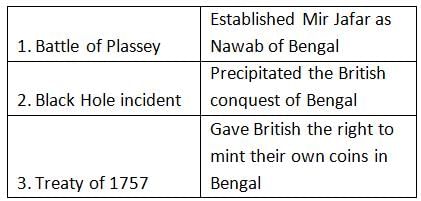Test: East India Company & Bengal Nawabs- 1 - Delhi Police Constable MCQ
20 Questions MCQ Test - Test: East India Company & Bengal Nawabs- 1
Consider the following pairs:
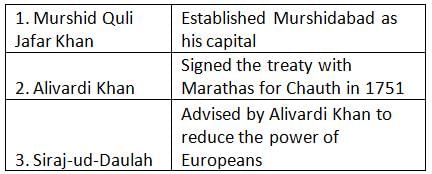
How many of the above pairs are correctly matched?

Consider the following statements:
- Murshid Quli Jafar Khan was appointed as the Governor of Bengal by Aurangzeb in 1705.
- Alivardi Khan defeated Sarfaraz Khan in 1740 to become the Nawab of Bengal.
- Siraj-ud-Daulah was challenged by his aunt Ghasiti Begum upon his succession.
How many of the statements given above are correct?
Assertion (A): The British victory in the Battle of Plassey led to significant economic exploitation of Bengal.
Reason (R): Following the battle, the British imposed heavy tributes on Bengal and monopolized trade, leading to economic decline.
Consider the following statements:
- Alivardi Khan was forced to pay the Marathas twelve lakh rupees annually as chauth after 1751.
- The Anglo-French conflicts in the Deccan led to Siraj-ud-Daulah adopting a neutral stance towards the Europeans in Bengal.
- The Black Hole incident led directly to the British decision to recapture Calcutta.
How many of the statements given above are correct?
Consider the following pairs:
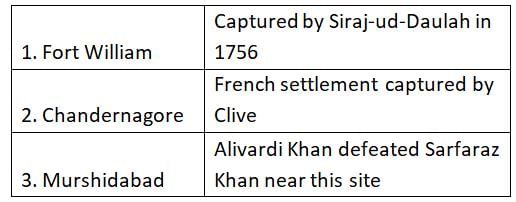
How many of the above pairs are correctly matched?
Consider the following statements:
- The treaty signed between Siraj-ud-Daulah and the British in 1757 allowed the British to fortify Calcutta.
- The Battle of Plassey resulted in the British receiving half of the stipulated amount immediately, with the remainder to be paid over three years.
- Mir Jafar agreed to not raise any fortifications near Hooghly after being placed on the throne.
How many of the statements given above are correct?
Assertion (A): Mir Jafar's ascent to the throne was largely engineered by the British.
Reason (R): The British sought a compliant ruler in Bengal to ensure their commercial and strategic interests were secured.
Consider the following statements:
- Clive was promised an annual income of 30,000 as a noble of the Mughal empire after the Battle of Plassey.
- The French were expelled from Bengal, Bihar, and Orissa as a result of a secret agreement before the Battle of Plassey.
- The Battle of Plassey established British supremacy in Bengal, eliminating other European powers.
How many of the statements given above are correct?
Consider the following pairs:
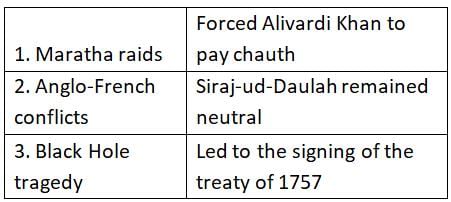
How many of the above pairs are correctly matched?
Consider the following statements:
- Siraj-ud-Daulah's attack on Calcutta was a response to the abuse of trade privileges by the British.
- The Battle of Plassey was a direct result of Siraj-ud-Daulah's violation of the 1757 treaty.
- The 1757 treaty allowed the British the right to coin their own money in Bengal, Bihar, and Orissa.
How many of the statements given above are correct?
Assertion (A): The Battle of Plassey was a turning point in Indian history, establishing British control over Bengal.
Reason (R): The battle demonstrated the effectiveness of British military strategy and the internal divisions within the Indian polities.
Consider the following statements:
- Statement-I: Siraj-ud-Daulah was advised by Alivardi Khan at his death-bed to reduce the power of Europeans in Bengal.
- Statement-II: The imperial firman of 1716-17 allowed the British to trade in Bengal without paying customs.
Which one of the following is correct in respect of the above statements?
Consider the following statements:
- Statement-I: The Black Hole tragedy directly led to the British's decision to fortify Calcutta further.
- Statement-II: Mir Jafar was compelled to agree to deliver up all the Frenchmen in Bengal, Bihar, and Orissa as part of his agreement with the British.
Which one of the following is correct in respect of the above statements?
Consider the following statements:
- Statement-I: The Battle of Plassey was significant primarily for demonstrating the internal dissensions within the Nawab’s state.
- Statement-II: After the Battle of Plassey, the British found no resistance from other European powers in Bengal.
Which one of the following is correct in respect of the above statements?
Assertion (A): The Maratha raids on Bengal severely disrupted the region's economy.
Reason (R): The raids forced the Nawab of Bengal to divert resources from development to military expenditure and tribute payments.
Consider the following statements:
- Statement-I: The Marathas occupied Orissa and encouraged rebellion against Alivardi Khan's rule.
- Statement-II: Siraj-ud-Daulah had a sympathetic attitude towards the English before coming to power.
Which one of the following is correct in respect of the above statements?
Consider the following statements:
- Statement-I: The Nawab's demands to surrender Krishnaballabh were refused by the British.
- Statement-II: The treaty of 9 February 1757 provided for the British to continue enjoying rights to dastaks within Bengal, Bihar, and Orissa.
Which one of the following is correct in respect of the above statements?
Consider the following pairs:
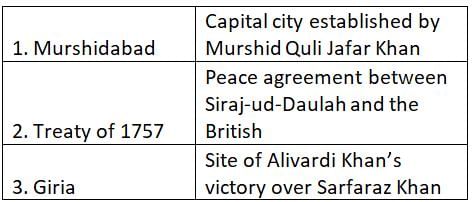
How many of the above pairs are correctly matched?
Assertion (A): Siraj-ud-Daulah's decision to attack the British led directly to his downfall.
Reason (R): Siraj-ud-Daulah underestimated the British military capabilities and their strategic alliances with his adversaries.



